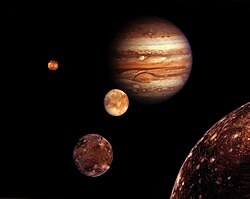 Discovery image of Margaret taken by the Subaru Telescope in August 2003 | |
| Discovery | |
|---|---|
| Discovered by | |
| Discovery date | August 29, 2003 [1] [2] |
| Designations | |
Designation | Uranus XXIII |
| Pronunciation | /ˈmɑːrɡərət/ [3] |
| Adjectives | Margaretian /ˌmɑːrɡəˈrɛtiən/ [4] |
| Orbital characteristics | |
Mean orbit radius | 14,345,000 km [5] [6] |
| Eccentricity | 0.6608 [6] (mean) |
| 1687.01 d | |
| Inclination | 57° (to the ecliptic) [5] |
| Satellite of | Uranus |
| Physical characteristics | |
| 10 km (estimate) [7] | |
| ~1,300 km2(estimate) | |
| Volume | ~4,200 km3(estimate) |
| Mass | ~5.5×1015 kg (estimate) |
Mean density | ~1.3 g/cm3(assumed) |
| ~0.0023 m/s2 (estimate) | |
| ~0.0085 km/s (estimate) | |
| ? | |
| ? | |
| Albedo | 0.04 (assumed) [7] |
| Temperature | ~65 K (estimate) |
Margaret is the only known prograde irregular satellite of the moons of Uranus. It was discovered by Scott S. Sheppard, et al. in 2003 and given the provisional designation S/2003 U 3. [8]
Contents
Confirmed as Uranus XXIII, it was named after the servant of Hero in William Shakespeare's play Much Ado About Nothing . [1] The name was also chosen to match the name of Sheppard's mother. [9]



